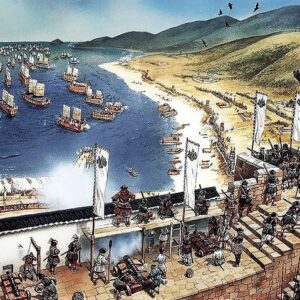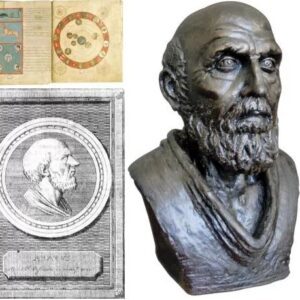Beginning with the inaugural computer to age-old manuscripts, vast expanses of jar-laden fields, and landscape engravings crafted centuries in the past, these are the mysteries that continue to baffle experts.
Antikythera Mechanism

The Antikythera mechanism (fragment A – front and rear); visible is the largest gear in the mechanism, approximately 13 centimetres (5.1 in) in diameter
The Antikythera mechanism, a 2,000-year-old artifact discovered in an ancient Greek shipwreck, has been dubbed the world’s first computer. Utilizing a wind-up dial system, it was capable of tracking the time for the Sun, Moon, and five planets, in addition to providing a calendar, the Moon’s period, and the occurrence of eclipses.
Many people speculated that it must have originated from extraterrestrial beings due to its sophistication, surpassing any other tool that would be created for the next millennium. While most researchers reject this hypothesis, they still remain uncertain about how the Greeks managed to develop such an advanced device, unlike anything we have ever seen from that era.
Voynich Manuscript
 The Voynich Manuscript is a document that is notable for its strange text, that to date hasn’t been decyphered. Theories range from a secret language or code to an old sort of joke
The Voynich Manuscript is a document that is notable for its strange text, that to date hasn’t been decyphered. Theories range from a secret language or code to an old sort of joke
The Voynich Manuscript, created in Central Europe 600 years ago, remains a mystery to scholars, as they have not been able to decipher its content or identify the language it is written in, due to its unique looped alphabet. Every year, new translation attempts are made by students, but none have proven successful thus far.
Recently, artificial intelligence proposed that the text might be a coded version of Hebrew; however, this study could only match 80% of the words to Hebrew and still failed to form coherent sentences. Carbon dating has confirmed that the Voynich Manuscript dates back to the 15th century. Interestingly, it features illustrations of plants that do not resemble any known species.
Plain of Jars

The Plain of Jars is a Laos field surrounded by mountains. No one knows why the huge stone jars, some of which are almost ten feet tall, were put there 2,500 years ago. Since there were human bones nearby, it’s possible that the jars were used to bury people or hold decaying bodies before they were burned or moved on to another portion of the funeral process.
Locals, on the other hand, say that the vessels held whiskey for a giant from legend or rice wine to celebrate how giants helped them beat their enemies. There are still unexploded U.S. bombs in the area from the Vietnam War, so only 7 of the 60 Plain of Jars locations are open to the public. From the first computer to ancient manuscripts, fields of jars, and carvings of landscapes made hundreds of years ago, these are the things that experts still don’t understand.
Roman Dodecahedrons

Their name is derived from their 12-sided structure, but experts can only concur on their shape. The Roman dodecahedrons were crafted from bronze or stone between 100 and 300 AD and featured a central hole. Some individuals believe that the 12 sides correspond to the 12 zodiac signs. Others speculate that these objects may have served as weapons, toys, or religious symbols.
Nazca Lines

Between 1 AD and 700 AD, the Nazca people of Peru cut 12 to 15 inches into rust-colored rock, revealing lighter-colored rock in deeper layers. The result was huge pictures of animals, plants, people, and geometric shapes carved into the ground. These pictures are best seen from an airplane.
Some crazy theories say that the carvings are evidence of aliens or ancient astronauts, but researchers can’t agree on more reasonable theories. Early researchers thought the Nazca Lines were about astronomy, but more recent theories say they were used to ask the gods for rain.
Paracas Candelabra

The Paracas Candelabra of the Andes, etched into a hill of hardened sand in Peru, shares similarities with the Nazca Lines but harbors its own mysteries. This 600-foot-long artwork, created around 200 BC, has an unknown meaning, even though its name implies it represents a candelabra.
Some believe it was crafted to honor Viracocha, the Incan god of creation. In contrast, others suggest it resembles the drug jimson weed and might have served to attract those who consumed it. From the first computer to ancient manuscripts, fields of jars, and enigmatic landscape carvings created centuries ago, these artifacts continue to baffle experts.
Thonis-Heracleion

Approximately 2,700 years ago, the Egyptian city of Thonis-Heracleion served as the gateway to the Mediterranean. However, the city’s core vanished from history for millennia. It wasn’t until the early 2000s that a group of divers stumbled upon some ancient artifacts.
In time, they uncovered an entire city submerged underwater near the Egyptian coast, replete with bridges, 16-foot statues, animal mausoleums, and other remarkable relics. Archaeologists remain uncertain as to how an entire city ended up in the Mediterranean Sea.
Linear A

Linear A and Linear B, two distinct yet related writing systems, have been discovered on ancient Minoan artifacts. However, researchers remain uncertain about the meaning of Linear A. Linear B, based on Greek, was deciphered in 1952 and consists of syllables rather than letters. Despite this knowledge, it has not aided in deciphering Linear A, which was in use from 1800 BC to 1450 BC.
Dogū

The Dogu are clay figurines resembling a fusion of human and animal features, created during Japan’s Neolithic Jomon period. Despite unearthing approximately 18,000 Dogu, ranging in age from 2,300 to 10,000 years old, archaeologists remain unsure of their purpose.
Some speculate that these everyday items were utilized as toys, while others suggest they might have symbolized fertility. From the earliest computers to ancient manuscripts, fields of jars, and landscape carvings crafted centuries ago, these enigmas continue to puzzle experts.
Sacsayhuaman

The Incan stone structure in Cusco, Peru, known as Sacsayhuaman, presents numerous questions. Initially believed to be a fortress, later evidence indicated its use for ceremonial purposes. Regardless of its function, Sacsayhuaman’s architecture is remarkable, with stones fitting together so precisely that they remain in place without the need for mortar.
Despite their seamless fit, the stones are not uniform in shape, suggesting that the builders may have improvised the design as they progressed. Sacsayhuaman remains an ancient mystery, as transporting the massive stones, which could weigh over 100 tons each, would have been a daunting task.





